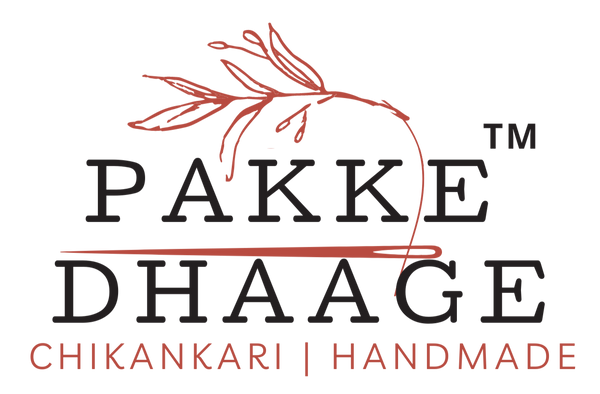
Lucknow's Living Art: Chikankari
Share
Part 1: The Wash
The foggy, cold morning betrayed none of the frenetic activity that begins well early in the winter and summer mornings alike. Pushkar ji had arrived. The first stop in our journey was perhaps the most gruelling. In the heart of Lucknow, a city celebrated for its refined culture and rich history - it is in the nondescript lanes, barely wide enough to walk in, is where true Chikankari reveals itself. Pushkar Ji confidently manoeuvred his bike as we arrived in a wide maidan, covered in milky fog.
It is in this maidan that the regular day of Chikankari begins - with the washers. It is 6 in the morning and I can already hear the loud splashes. In nearly freezing temperatures, several men stand waist-deep in wide water tanks, washing the freshly embroidered clothes in almost a musical rhythm. I see the familiar motifs and the usual smell of dyes, that gives Chikankari its almost alive colours. With each splash, some of that dye washes off. Winters are tough - sunlight will be sparse and drying slow. Which is why contrary to what one would expect, washing here begins earlier in the winters.
We stay with the washers for a couple of hours - as I help out with the drying, and we wait for the sunlight to be bright enough for me to click some pictures. After what seems like hours - we sit down for a well earned Chai and share stories. The chai is too sweet for my taste but, as I learn from the stories, essential glucose burst for all the washers - for whom this is only one of their many jobs they juggle through the day.
His family has lived forever in Munni Khera, a few hours from Lucknow. And almost everyone has had a connection with Chikankari. He himself started in the tradition by learning to carve the wooden blocks (thappis) for Chikankari.
Part 2: The Thappi
Pushkarji’s family was amongst the first artisans we started working with to create Pakke Dhaage. He remembers learning the family trade when he was 8 years of age - and his first assignment was carving Shissoo wood blocks - a painfully slow and deliberate process. It is on these wooden blocks that the motifs of Chikankari first take shape - the first source of imperfection that makes every Chikankari article unique. And together we head to see this imperfection come alive - with Nandoo Ji - our Chhappakar.
Each artisan has a dominant hand, a peculiar stroke - each block of wood is different in its malleability, dryness and more. And thus, each motif is different - even if it was mechanically imagined on a computer screens as many modern ones are. Nandoo ji is busy carving away as we sip another cup of Chai. And the considered movement of his hands - and the concentration that it takes does not prevent him from telling us all the mistakes we had made with our latest designs and what we need to change.
He often weighs in on our designs - and for two reasons we find his advice incredibly useful. One, he knows, before even the embroidery begins - which curves will pose a challenge for the artisans - which lines take the design too far. And two, the magic of Chikankari work lies in its subtlety. Unlike heavy, opulent embroideries, Chikankari means understated grace. And he is quick to point out when we go overboard.
Part 3: The Needle and Thread
Traditionally done on fine muslin cloth, Chikankari has evolved to grace a variety of fabrics like cotton, georgette, crepe, silk, and chiffon, while the classic 'white-on-white' remains an all-time favourite.
But all cloths do not lend themselves to all the multiple stitches of Chikankari. The delicate 'jaali' (a lace-like, open-work stitch) creates a web of patterns and adorns most of Viscose Kurtis and sets you see. The raised and intricate 'bakhiya' (shadow work) is more common on cotton sets and modal kurtis. And in the tiny 'tepchi' (running stitch), every stitch contributes to a beautiful, cohesive design creating more premium garments like fine silk & cotton Kota Doria unstitched suits and Georgette lehengas.
Our next stop is to see the progress on our upcoming Lehenga collection. The work on this began 6 months back, and yet each Lehenga will take 18 more months to become a final product! Even if the final creation is far away - I cannot but revel in the beauty of what it already looks like. Pure elegance in play.
Part 4: From Mughal Courts to Modern Wardrobes
I end my day breaking bread with Pushkar Ji and his family. And his grandfather breaks into his memory treasures to regale us with stories of a different time. The history of Lucknow embroidery is as rich and fascinating as the craft itself. Legend has it that the art form was introduced to India by the Mughal Empress Nur Jahan, the wife of Emperor Jahangir. A lover of all things beautiful and refined, she brought this Persian craft to the Mughal court, where it flourished and became a symbol of royal sophistication.
Contrary to popular opinion, the artisans came from all religions - as Hindu and Muslim families in the villages near Lucknow, took to learning the art, making it more accessible. Lucknow Chikankari moved from the courts to the homes of the city's nobility and, eventually, to the everyone. And as the clothes evolved - their function changed from formality to bomfort and breathability. While the techniques and motifs have been preserved, artisans have also adapted the craft to modern sensibilities - a trend that Pushkar Ji’s grandfather wasn’t too happy about. A worthy sentiment from a man who once refused to refused to bow down to the British provincial officer.
Conclusion: So what do I really feel about Chikankari?
A Chikankari piece is not just about buying a garment. It is a piece of work that many hands put their hearts and soul into. Each article we make goes through as many as 20 hands. Our talented artists hand-make and remake the designs multiple times. The Chhappadars carve each motif by hand, often remaking them - just to get one small centimetre right. The Rangrez take multiple attempts to get the colours the way we want them. Each garment undergoes at least 3-separate washes. Sometimes even 6 women work together on the garment, each excelling in their unique stitch. And any embellishment you put - Moti work, sequins, cut-dana, pearl - everything ties the story of another person to the story of your garment, and the charm of all that history.
I love each one of those stories. I love its history. I’m in awe of the hard-work it takes every single one of those people put into it. I love Chikankari. Every deliberate detail of it.
Community Note:
Supporting Artisans: When you buy Chikankari online from our store, you are directly supporting the skilled artisans who have dedicated their lives to preserving this beautiful heritage craft.
Privacy: Some names in the blog have been changed - to maintain the privacy of the people.
Our Commitment to Authenticity: At Pakke Dhaage, we are passionate about bringing the true essence of Chikankari to you. Each piece in our collection is a testament to the skill and dedication of our artisans. We work directly with master craftspeople in Lucknow to ensure that every stitch is (im)perfect and every design is a work of art.
We invite you to explore our collection and discover the unparalleled beauty and grace of Chikankari. Let these handcrafted pieces add a touch of timeless elegance to your life.






